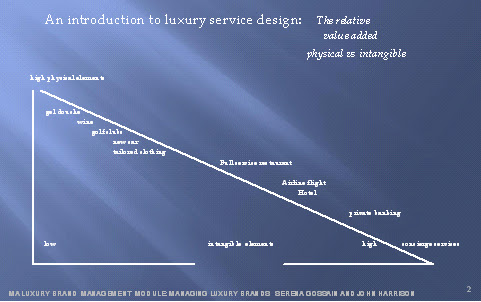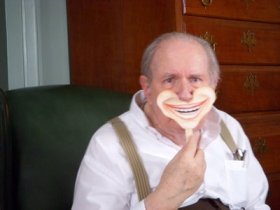The Service Model
This class focused on the service model. My interests are in the service industry, and my project is about coming up with a Moet and Chandon Penthouse. I personally believe that flawless service often results in purchase and repeat purchase. I believe this because it is the quality of service that gets the consumer back.
Personally I have often experienced that the better the service is the more likely I am to go back to a particular restaurant or hotel.
James D. Roumeliotis from the WhiteField Colsulting Worldwide also said that "great service is one of the most important reasons customers will choose to do business with you on frequent basis."
(Defining Luxury Brands: Business, Posted on February 28, 2011, Viewpoint by James D. Roumeliotis, WCW Columnist)
The higher in price one goes, the higher the service is needed to convince the customer and keep the customer happy. The relative value added physical vs. intangible. An example of this is given below:
(Reference: Module Slides, Class Lecture: Serena Gossain and John Harrison)
The value added is the extra features of an item of interest that is beyond what is normally the standard expectations. The vale added often results in giving the company competitive edge in the marketplace. This value add is essential in luxury brands.
"Today, consumer purchase decisions are increasingly driven by consumers’ hearts. With ambiance marketing, a custom designed attractive setting – yet alluring with captivating style, invites customers to truly feel the brand experience by adding character. This is accomplished by connecting the emotions to a product or service, and infusing it with a tangible and intangible essence that remain in the customers’ minds." James D. Roumeliotis from the WhiteField Colsulting Worldwide
In the past, the service sector suffered because each service was treated as an isolated event.
This model was used extensively used in the 70s 80sand 90s: it was known as the crafts model.
The value added is the extra features of an item of interest that is beyond what is normally the standard expectations. The vale added often results in giving the company competitive edge in the marketplace. This value add is essential in luxury brands.
"Today, consumer purchase decisions are increasingly driven by consumers’ hearts. With ambiance marketing, a custom designed attractive setting – yet alluring with captivating style, invites customers to truly feel the brand experience by adding character. This is accomplished by connecting the emotions to a product or service, and infusing it with a tangible and intangible essence that remain in the customers’ minds." James D. Roumeliotis from the WhiteField Colsulting Worldwide
In the past, the service sector suffered because each service was treated as an isolated event.
This model was used extensively used in the 70s 80sand 90s: it was known as the crafts model.
-> In the 1990s: most service providers turned their attention back to the human element. They got got rid of the 'instructed smiles' and moved on to 'personalized service'. This meant that employees were empowered to customize the service encounter to the individual characteristics of customers.
Personalized service: Many organizations do have service elements to the products they sell.
When it comes to services consumers tend to be more demanding because services are time bound. Unlike products, consumer cannot hold on to services they can only measure it in terms of the time and for this reason a consumer paying for a service is expecting quality service for the duration.
Intangible: the experience consumers obtain from the service has an impact on how they will perceive it.
Perishability: Services last a specific time and cannot be stored like a product. For this reason when it comes to service consumer except to get what they are paying for. Consumers tend to be exceptionally demanding and expect nothing but the best.
The service industry uses the flower of service to uniquely deliver their offerings:
This states that each service has to unique and excellent in order to satisfy the customer.
In class we did an activity on the 8P's of Marketing in relation to the service industry. We were asked to rank the 8P's in relation to a service of our choice.
The 8P's are as follows:
¨Product elements.
¨Place and time.
¨Price and other outlays.
¨Promotion and Education
¨Physical environment.
¨Processes
¨People
¨Productivity and quality.
My group and I choose an Indian luxury hotel called Taj Palace. Given below is a picture of our findings:
-> High Context vs. Low Context service: High context service is where the employee is in high contact with the customer, and low context is where the employee has less contact. Whatever the level of contact employee development, training and attention to the employees well being are very important in the service industry. This is because the employee needs to be happy in order to service consumers in the best of their ability. Employees outcomes are associated with customer satisfaction and hence related to the financial performance of a brand.
We ended the lecture by discussing what we felt employees had to be in order to work in the luxury sector. The class findings are given below:
Reference:
1) Module Slides, Class Lecture: Serena Gossain and John Harrison
2) (Defining Luxury Brands: Business, Posted on February 28, 2011, Viewpoint by James D. Roumeliotis, WCW Columnist)
http://www.whitefieldconsulting.com/wordpress/?p=7350
http://www.whitefieldconsulting.com/wordpress/?p=7350















No comments:
Post a Comment